Evaluation of Appropriate Hysteresis Model for Nonlinear Dynamic Analysis of Existing Reinforced Concrete Moment Frames
Abstract
:1. Introduction
2. Analysis Models
3. Results and Discussion
3.1. Comparison of NSA and NDA Results
3.2. Overall Responses
3.3. Column Members
3.4. Beam Members
3.5. Evaluation of an Appropriate Hysteresis Model
4. Conclusions
Author Contributions
Funding
Institutional Review Board Statement
Informed Consent Statement
Data Availability Statement
Conflicts of Interest
References
- Pinho, R. Nonlinear Dynamic Analysis of Structures Subjected to Seismic Action; University of Pavia: Pavia, Italy, 2007; pp. 65–89. [Google Scholar]
- Li, Y.R. Nonlinear Time History and Push-Over Analyses for Seismic Design and Evaluation. Ph.D. Thesis, University of Texas, Austin, TX, USA, 1996. [Google Scholar]
- Clough, R.W.; Johnston, S.B. Effect of stiffness degradation on earthquake ductility requirements. In Proceedings of the Japan Earthquake Engineering Symposium, Tokyo, Japan, October 1966; pp. 195–198. [Google Scholar]
- Takeda, T.; Sozen, M.A.; Nielsen, N.N. Reinforced concrete response to simulated earthquakes. J. Struct. Div. 1970, 96, 2557–2573. [Google Scholar]
- Takayanagi, T.; Schnobrich, W.C. Computed Behavior of Reinforced Concrete Coupled Shear Walls; University of Illinois: Urbana, IL, USA, 1976. [Google Scholar]
- Saatcioglu, M.; Derecho, A.T. Dynamic inelastic response of coupled shear walls as affected by axial forces. In Proceedings of the CSCE–ASCE–ACI–CEB International Symposium on Nonlinear Design of Concrete Structures, Waterloo, ON, Canada, 7–9 August 1979; pp. 639–670. [Google Scholar]
- Ozcebe, G.; Saatcioglu, M. Hysteretic shear model for reinforced concrete members. J. Struct. Eng. 1989, 115, 132–148. [Google Scholar] [CrossRef]
- Stojadinovic, B.; Thewalt, C.R. Energy balanced hysteresis models. In Proceedings of the 11th World Conference on Earthquake Engineering, Acapulco, Mexico, 23–28 June 1996. [Google Scholar]
- Dowell, O.K.; Seible, F.; Wilson, E.L. Pivot hysteresis model for reinforced concrete members. ACI Struct. J. 1998, 95, 607–617. [Google Scholar]
- Sezen, H.; Chowdhury, T. Hysteretic model for reinforced concrete columns including the effect of shear and axial load failure. J. Struct. Eng. 2009, 135, 139–146. [Google Scholar] [CrossRef]
- Zimos, D.K.; Mergos, P.E.; Kappos, A.J. Shear hysteresis model for reinforced concrete elements including the post-peak range. In Proceedings of the COMPDYN 2015-5th ECCOMAS Thematic Conference on Computational Methods in Structural Dynamics and Earthquake Engineering, Crete Island, Greece, 25–27 May 2015. [Google Scholar]
- Xu, S.Y.; Zhang, J. Hysteretic shear–flexure interaction model of reinforced concrete columns for seismic response assessment of bridges. Earthq. Eng. Struct. Dyn. 2011, 40, 315–337. [Google Scholar] [CrossRef]
- Allouzi, R.; Irfanoglu, A. Development of new nonlinear dynamic response model of reinforced concrete frames with infill walls. Adv. Struct. Eng. 2018, 21, 2154–2168. [Google Scholar] [CrossRef]
- Bouc, R. A mathematical model for hysteresis. Acta Acust. United Acust. 1971, 24, 16–25. [Google Scholar]
- Wen, Y.K. Method for random vibration of hysteretic systems. J. Eng. Mech. 1976, 102, 249–263. [Google Scholar]
- Manzoori, A.; Toopchi-Nezhad, H. Application of an extended BOUC-WEN model in seismic response prediction of unbonded fiber-reinforced isolators. J. Earthq. Eng. 2017, 21, 87–104. [Google Scholar] [CrossRef]
- Kim, S.Y.; Lee, C.H. Description of asymmetric hysteretic behavior based on the BOUC-WEN model and piecewise linear strength degradation functions. Eng. Struct. 2019, 181, 181–191. [Google Scholar] [CrossRef]
- Pelliciari, M.; Briseghella, B.; Tondolo, F.; Veneziano, L.; Nuti, C.; Greco, R.; Lavorato, D.; Tarantino, A.M. A degrading Bouc–Wen model for the hysteresis of reinforced concrete structural elements. Struct. Infrastruct. Eng. 2020, 16, 917–930. [Google Scholar] [CrossRef]
- Saiidi, M.; Sozen, M.A. Simple and Complex Models for Nonlinear Seismic Response of Reinforced Concrete Structures; University of Illinois: Urbana, IL, USA, 1979. [Google Scholar]
- Computers and Structures, Inc. (CSI). Analysis Reference Manual for SAP2000, ETABS, and SAFE; CSI: Berkeley, CA, USA, 2009. [Google Scholar]
- Sharma, A.; Eligehausen, R.; Reddy, G.R. Pivot hysteresis model parameters for reinforced concrete columns, joints, and structures. ACI Struct. J. 2013, 110, 217–227. [Google Scholar]
- Kang, J. A Study on the Seismic Retrofit Techniques of School Buildings Constructed in Accordance with Standard Design in 1980s. J. Korean Soc. Hazard. Mitig. 2012, 12, 1–7. [Google Scholar] [CrossRef]
- Kim, J.S.; Yoon, T.-H. Inelastic Seismic Behavior of Low-story Standard School Buildings according to Characteristics of Earthquake Loads and Hysteresis Models. J. Korea Acad. Ind. Coop. Soc. 2012, 13, 4294–4301. [Google Scholar]
- Je, J.H.; Kim, J.-S.; Yoon, T.-H. Inelastic Behavior of Standard School Building according to Hysteresis Models. J. Korea Acad. Ind. Coop. Soc. 2009, 10, 838–845. [Google Scholar]
- Son, J.-K.; Lee, C.-H. Hysteresis Model for the Cyclic Response of Existing Reinforced Concrete Frames. J. Korean Assoc. Spat. Struct. 2020, 20, 81–89. [Google Scholar] [CrossRef]
- Oh, S.H.; Choi, S.M.; Ryu, H.S.; Kim, Y.J.; Choi, K.Y. Static Loading Test for Performance Evaluation of Dual-Frame Type Seismic Retrofit System. J. Korean Soc. Adv. 2019, 10, 38–47. [Google Scholar] [CrossRef]
- Lee, T.H.; Kim, S.H.; Kim, B.K.; Oh, S.H.; Choi, S.M. Lateral Cyclic Loading Experiment for Seismic Performance of Two-Storied RC Structure Frame Retrofitted with External Steel Rod Damper. J. Korean Soc. Adv. Compos. Struct. 2019, 10, 24–32. [Google Scholar] [CrossRef]
- Ministry of Land, Infrastructure and Transport (MOILT). General Seismic Design (KDS 17 10 00); MOILT: Sejong, Korea, 2018. [Google Scholar]
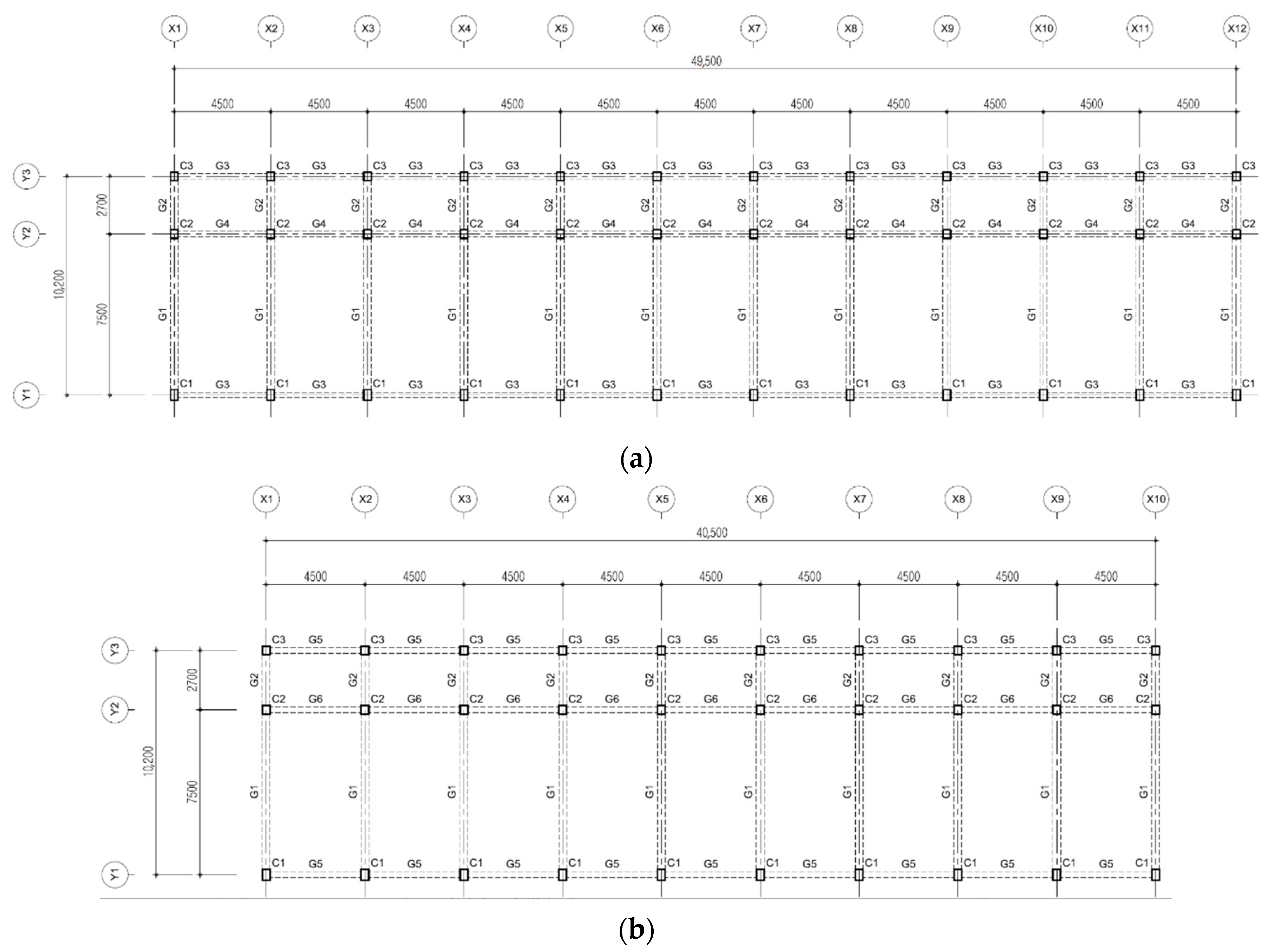
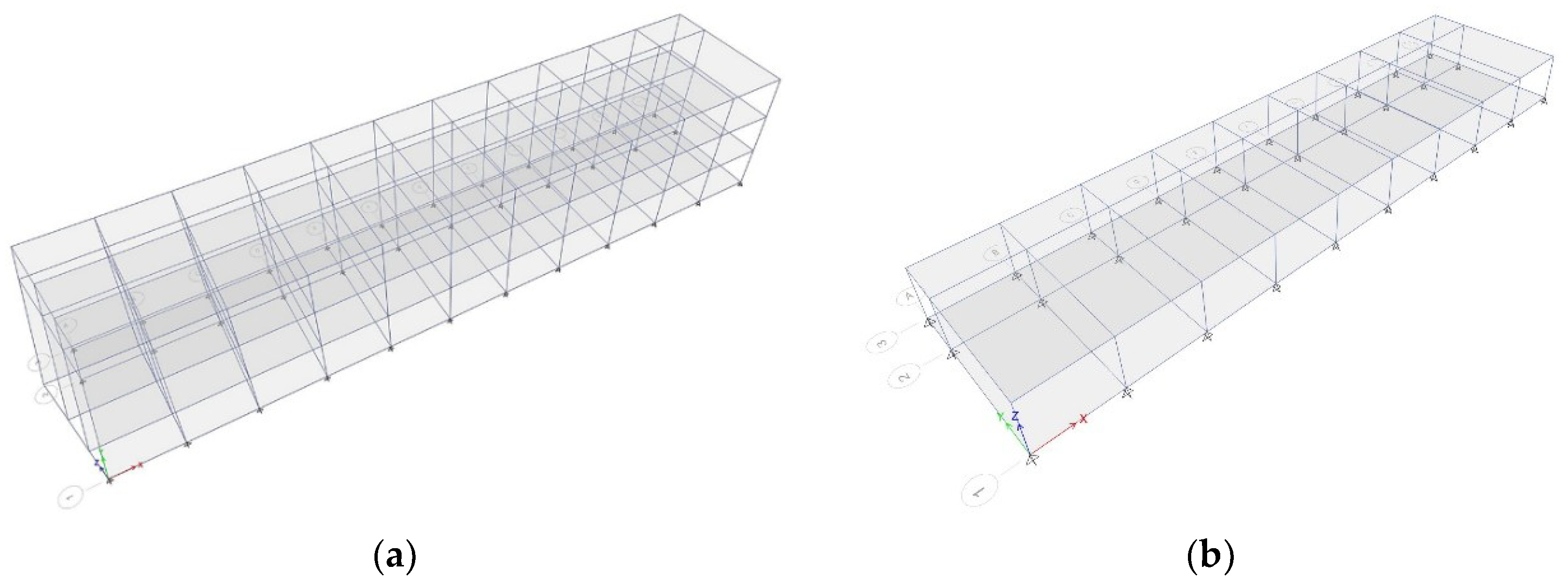
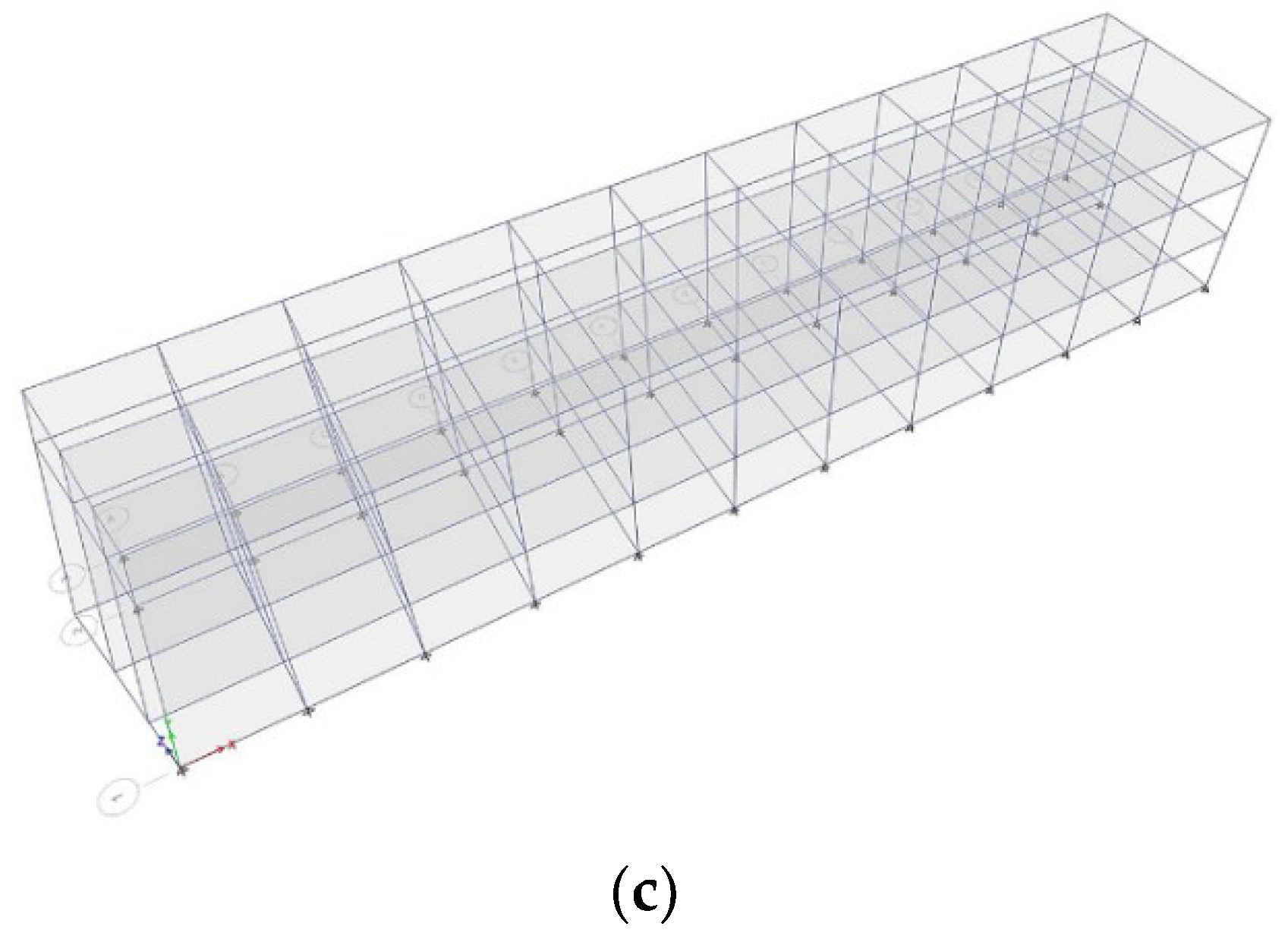

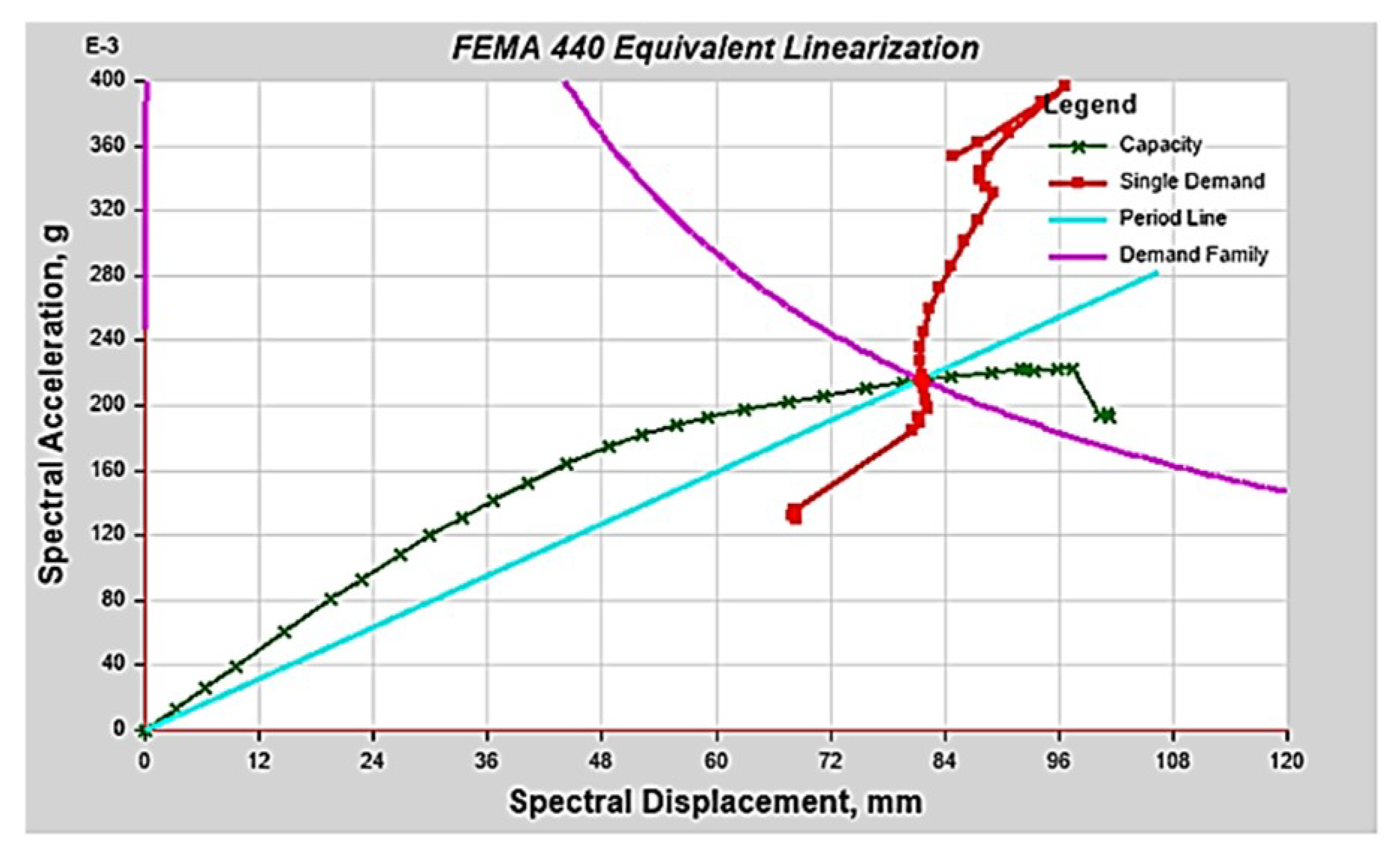
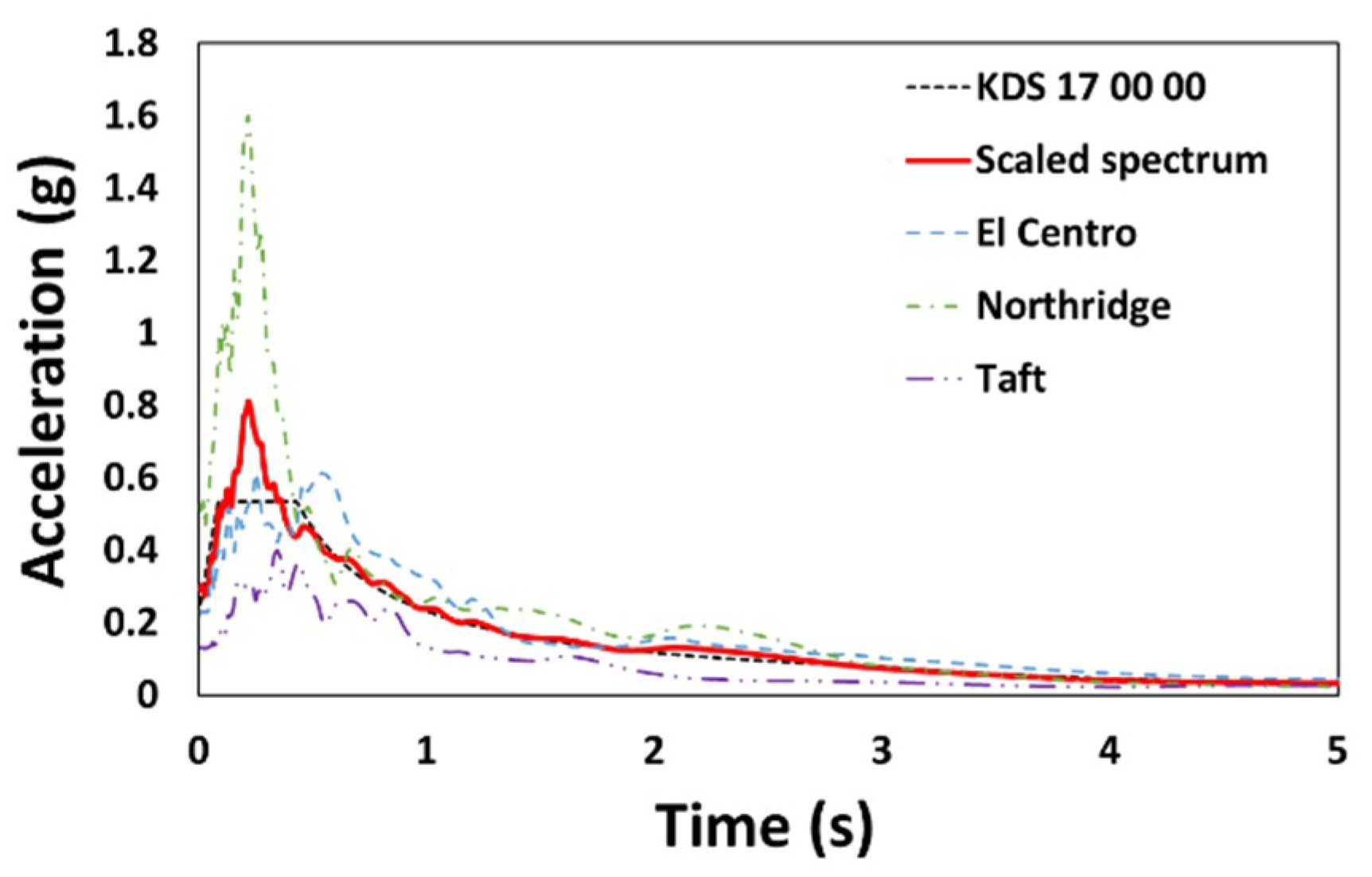
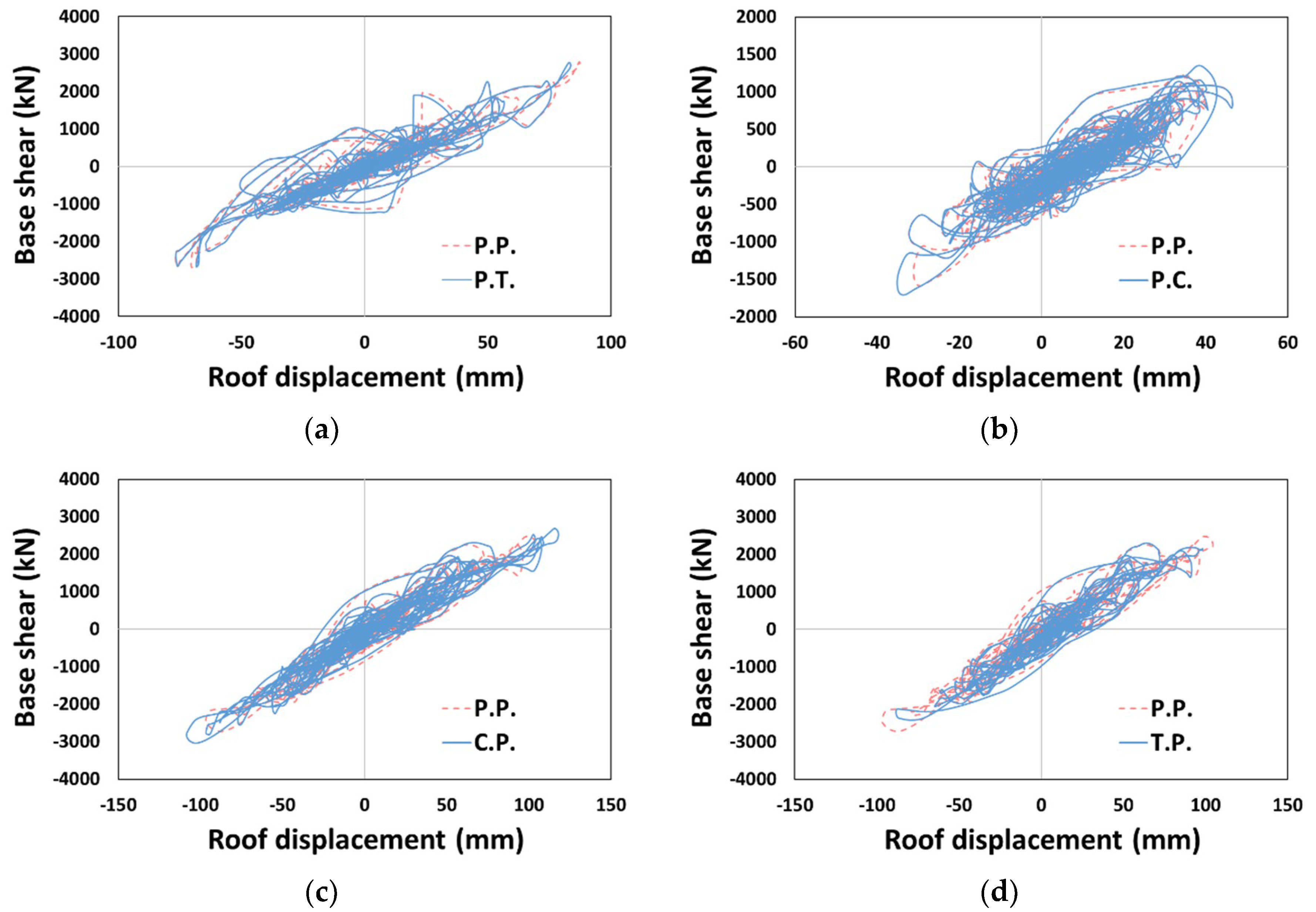
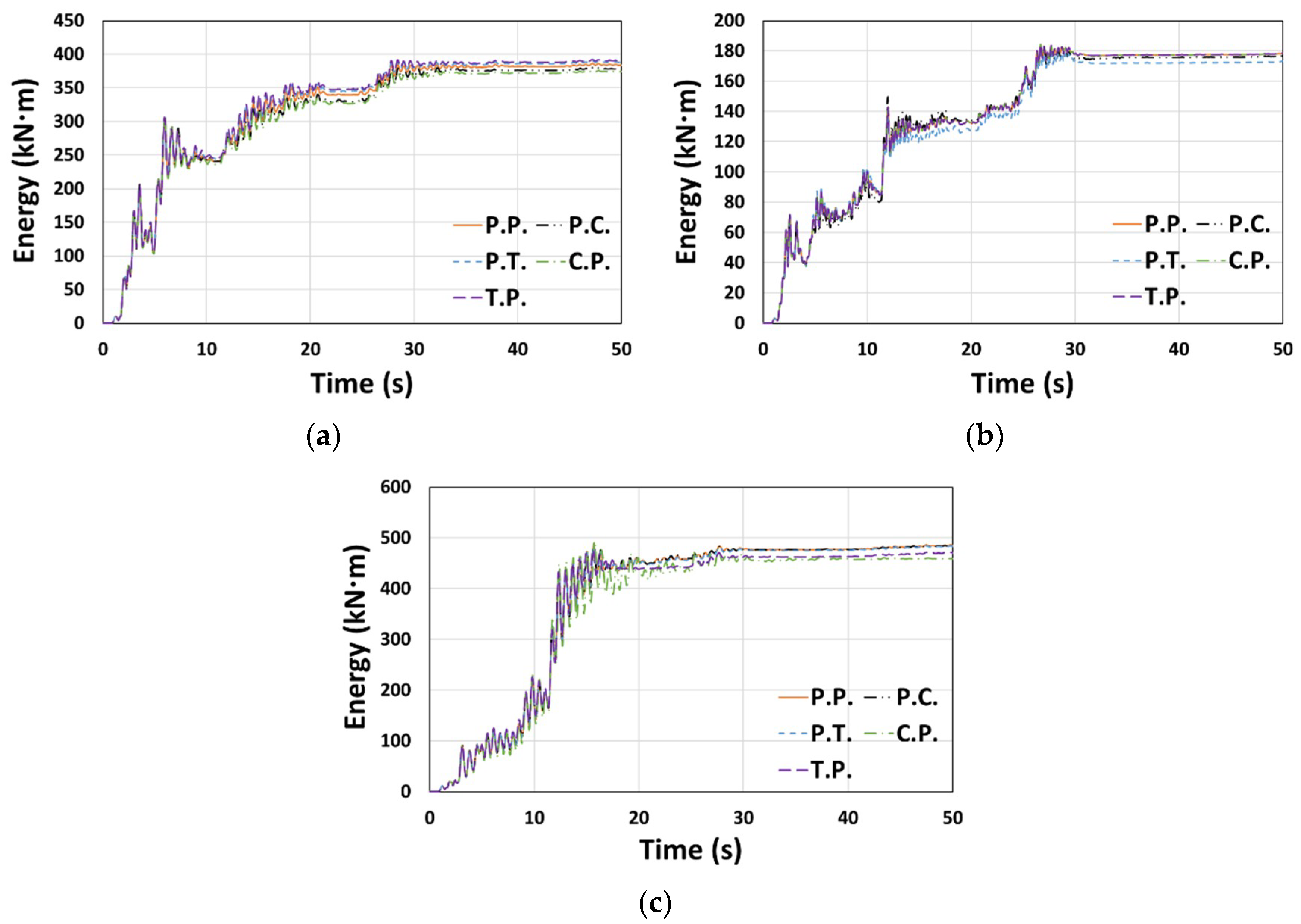
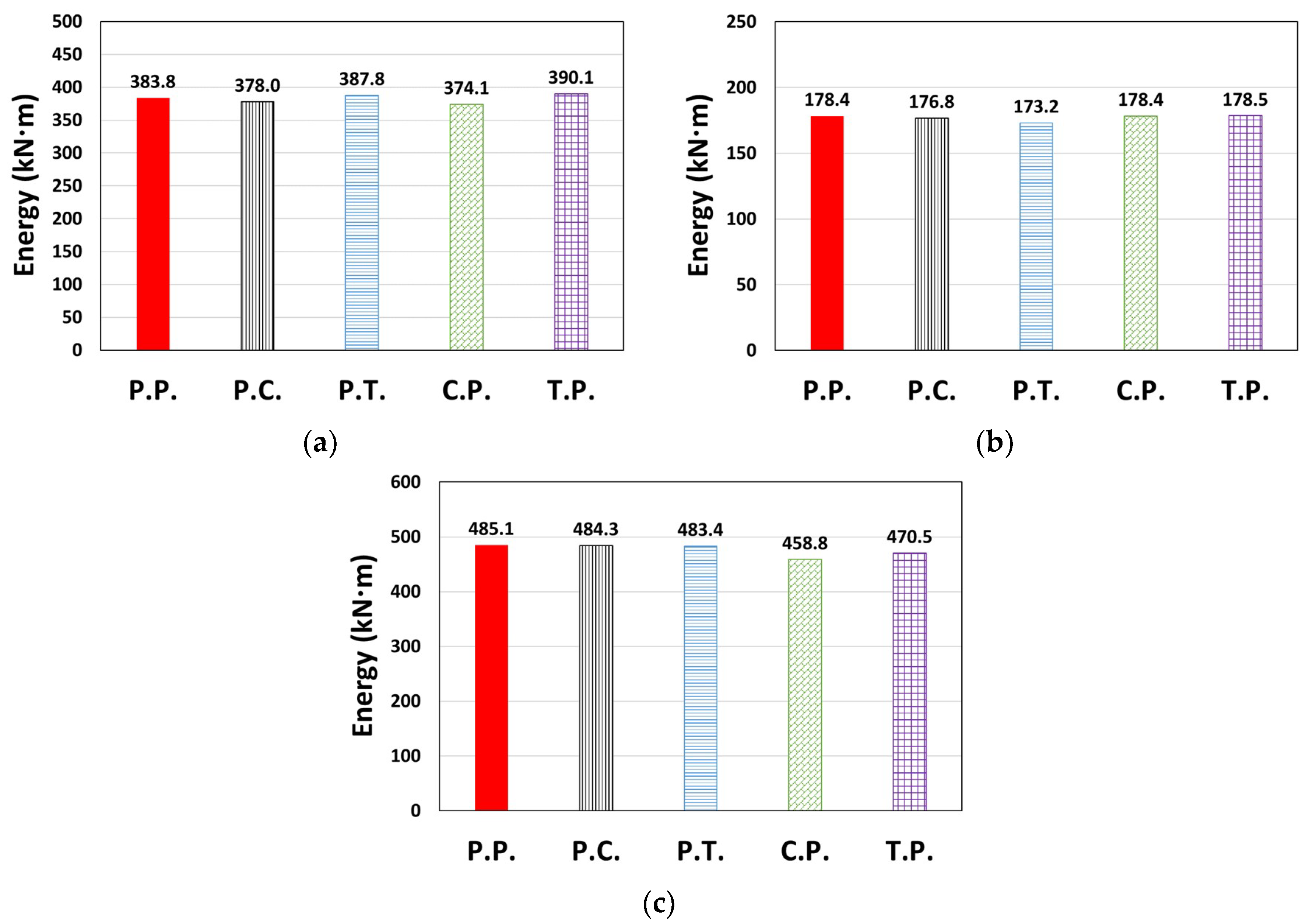
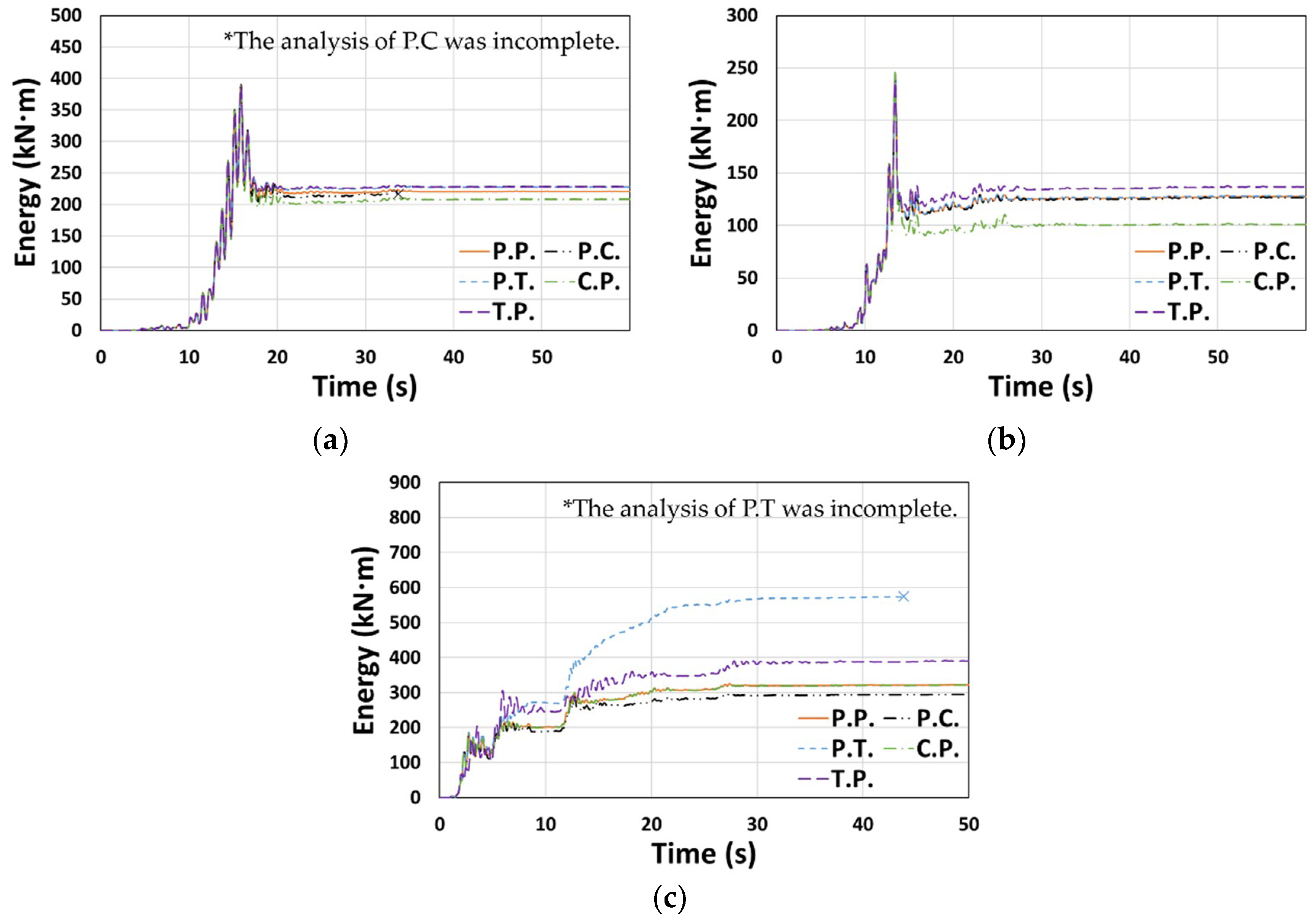
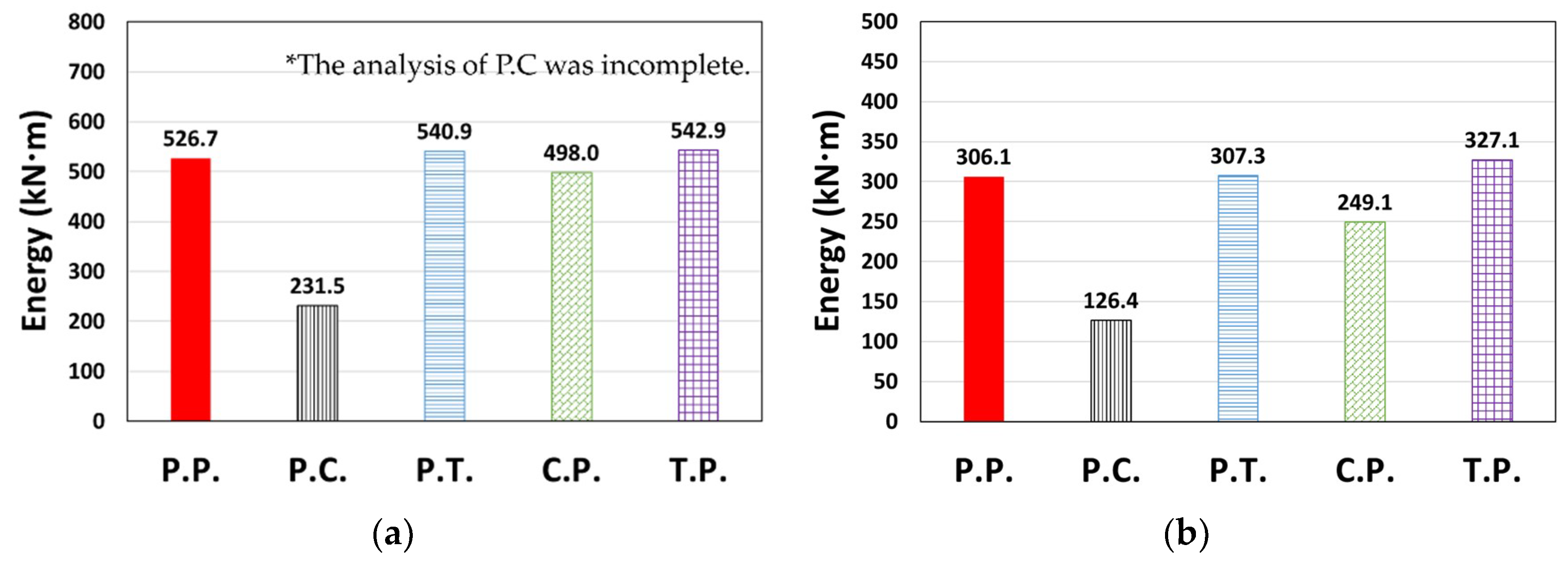
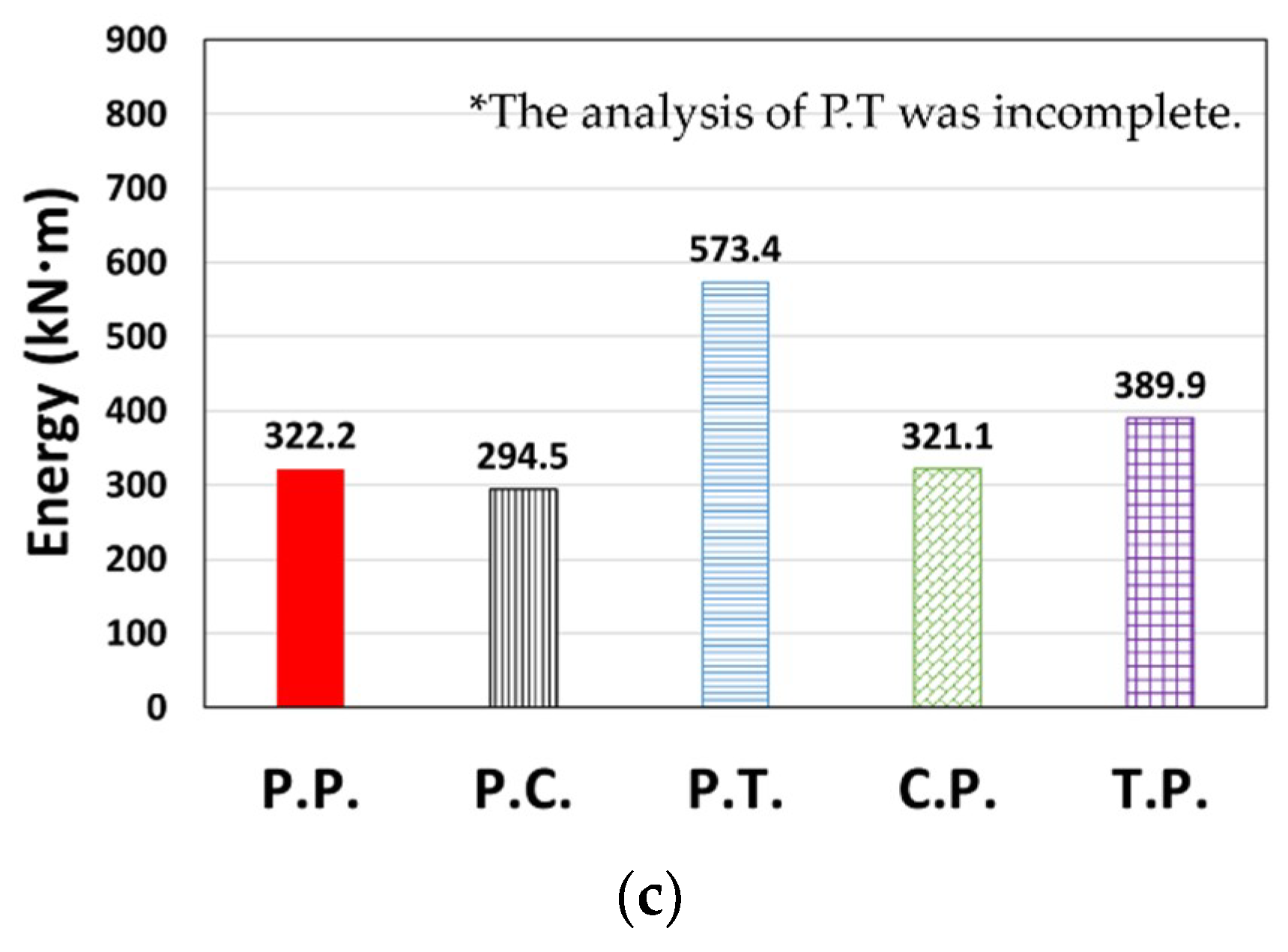
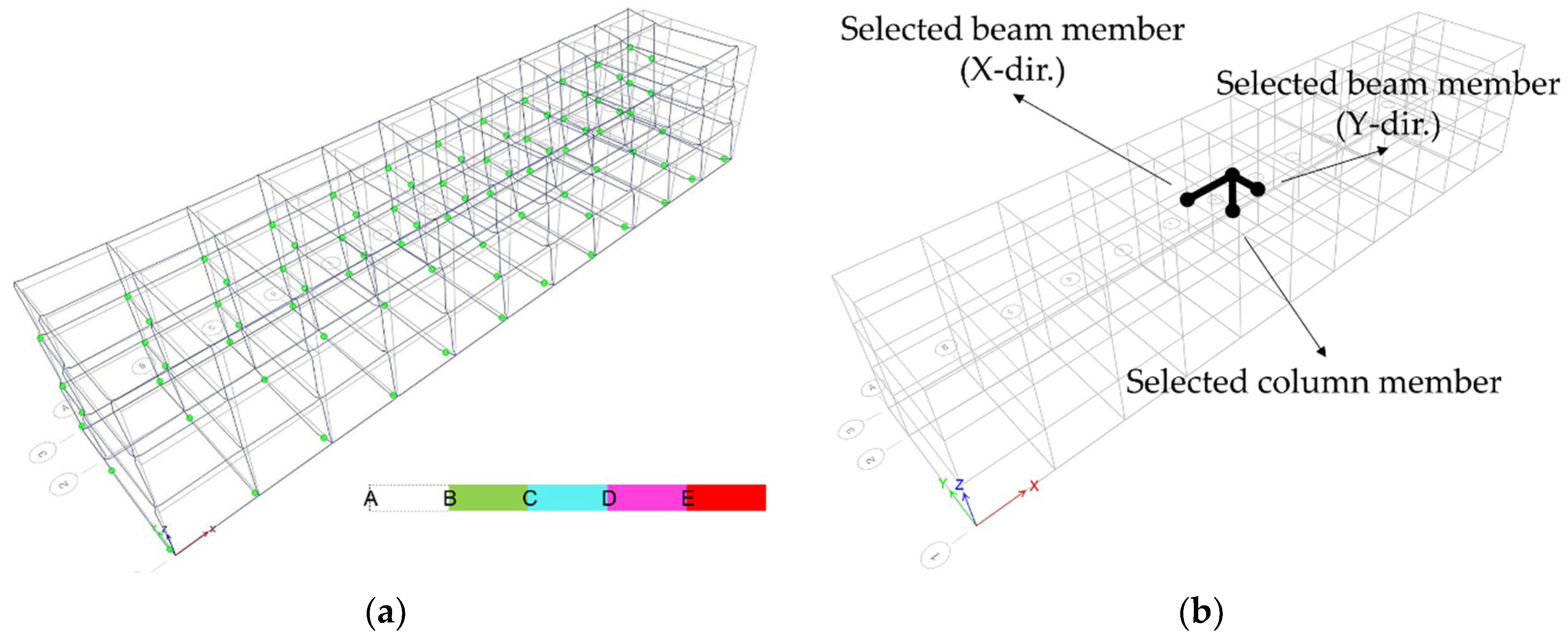
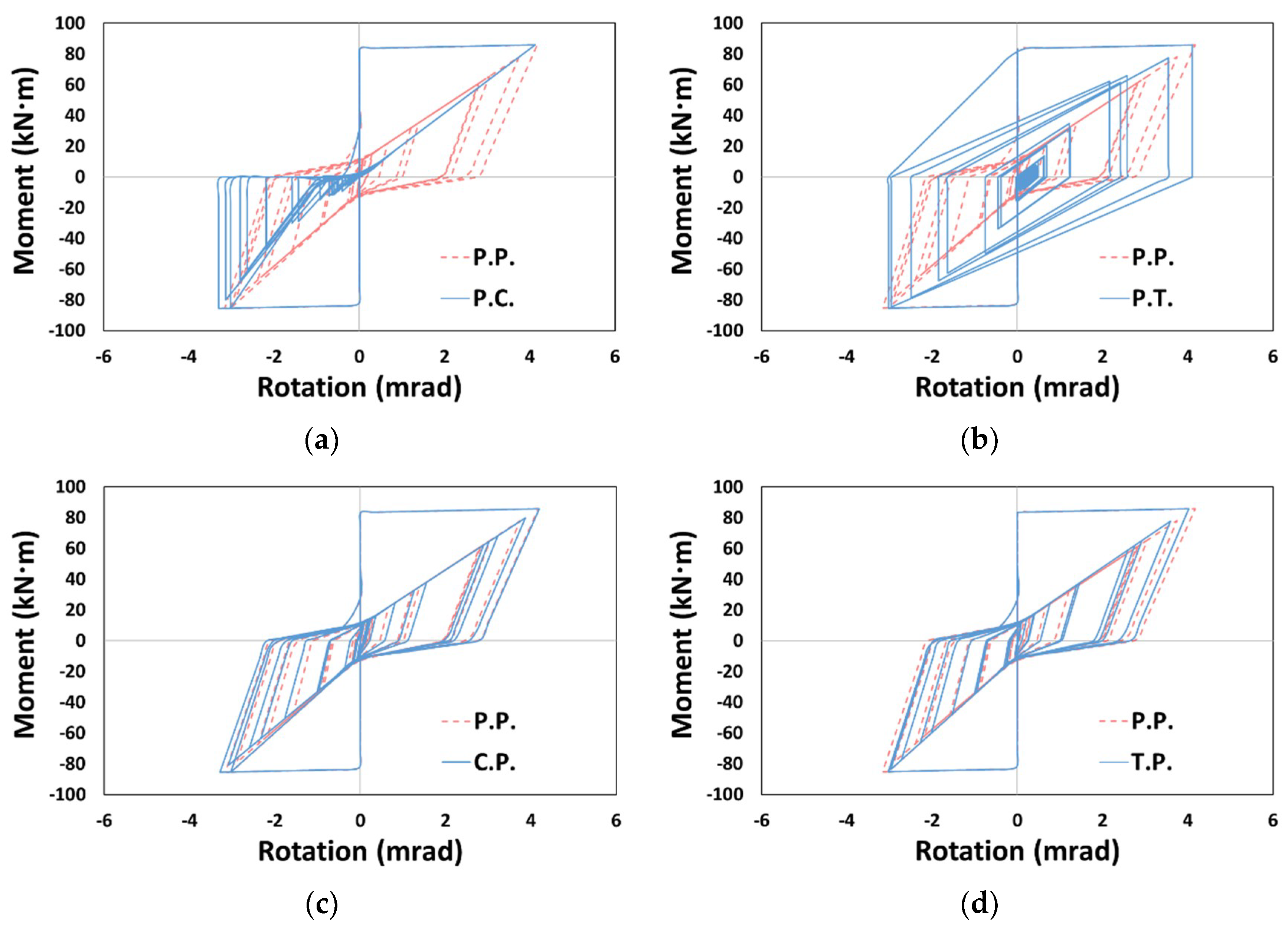
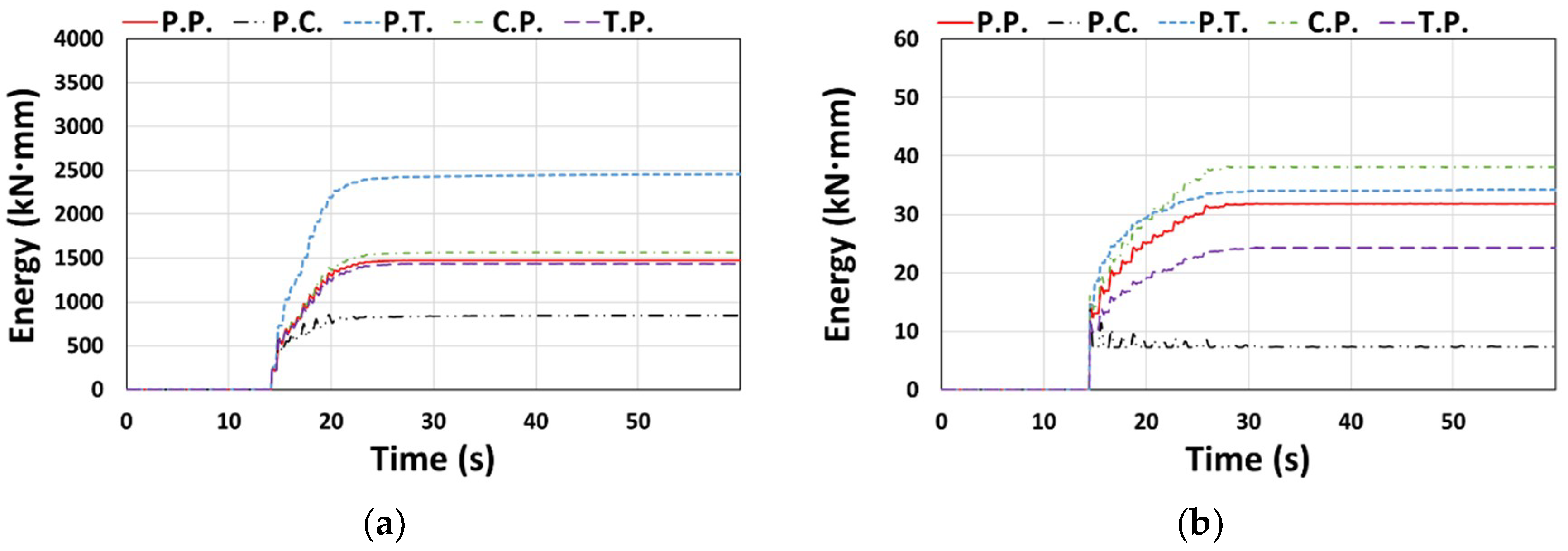
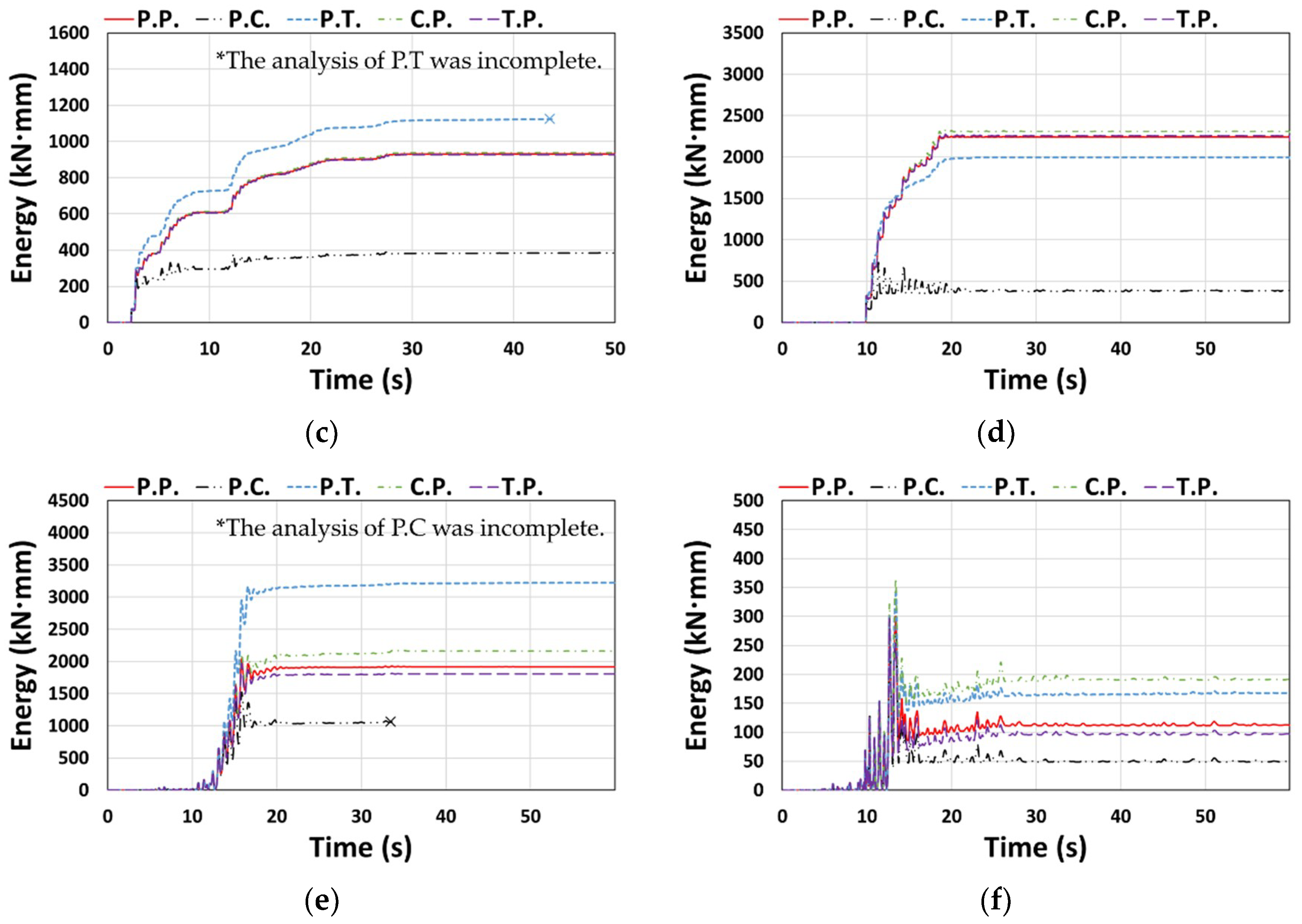

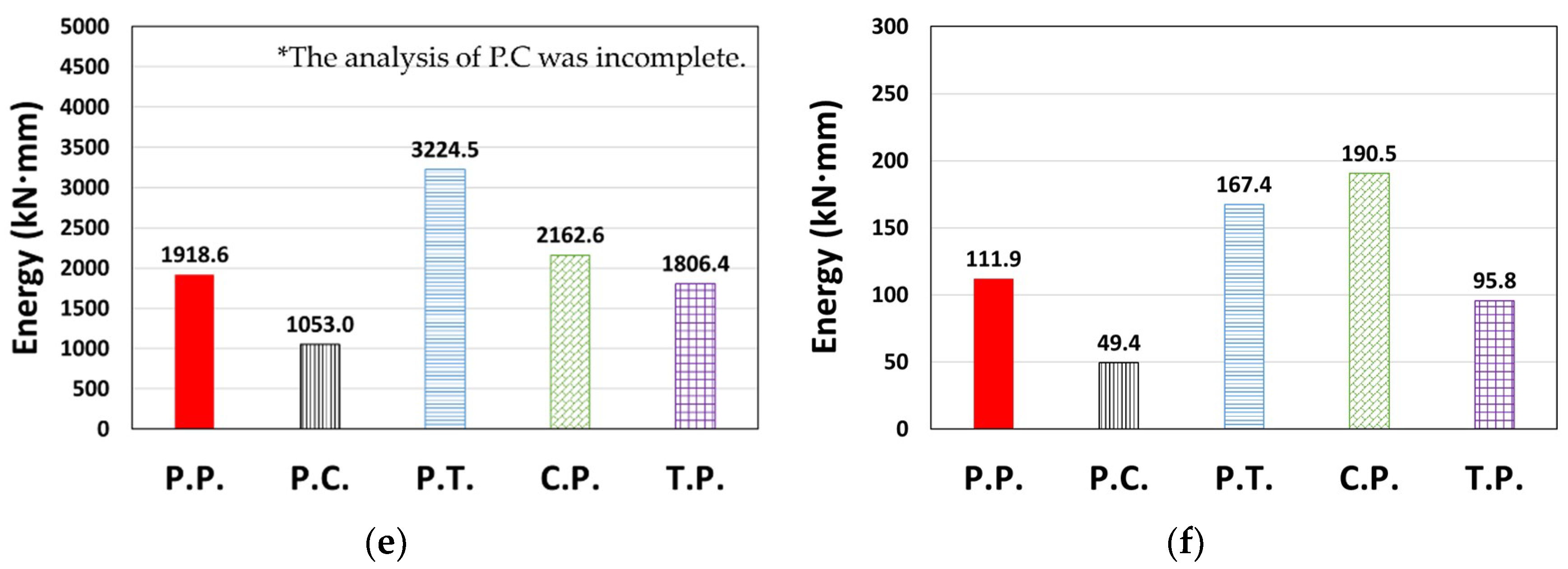
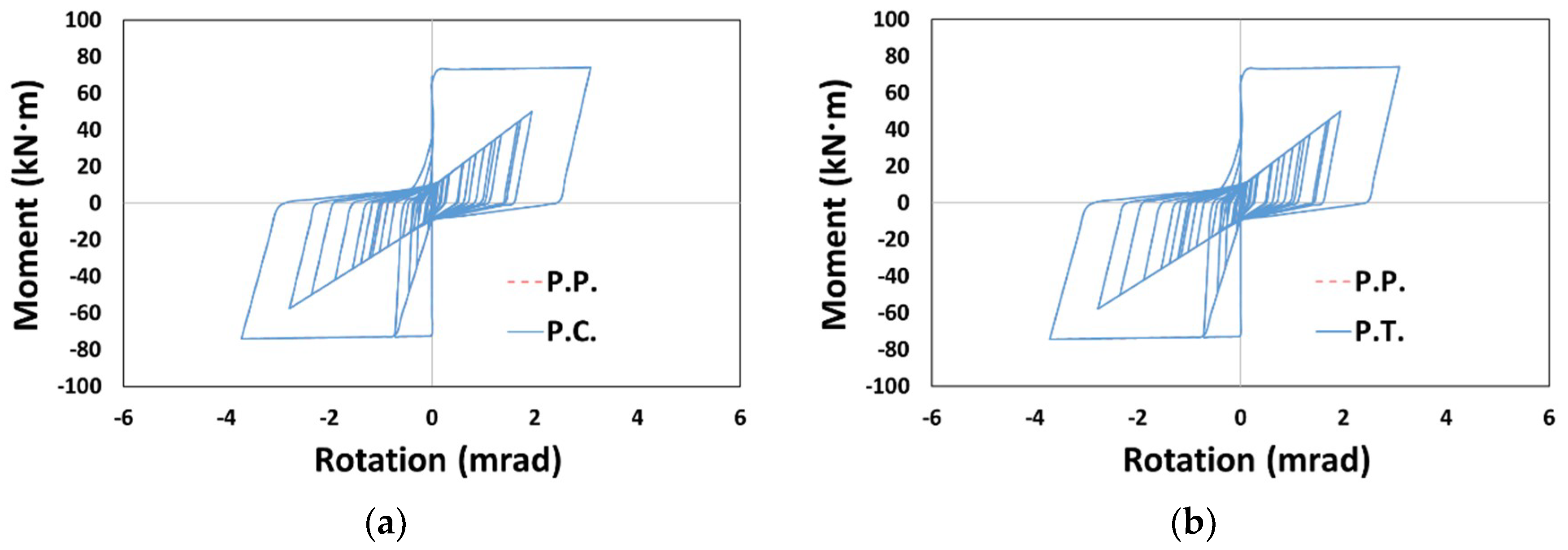
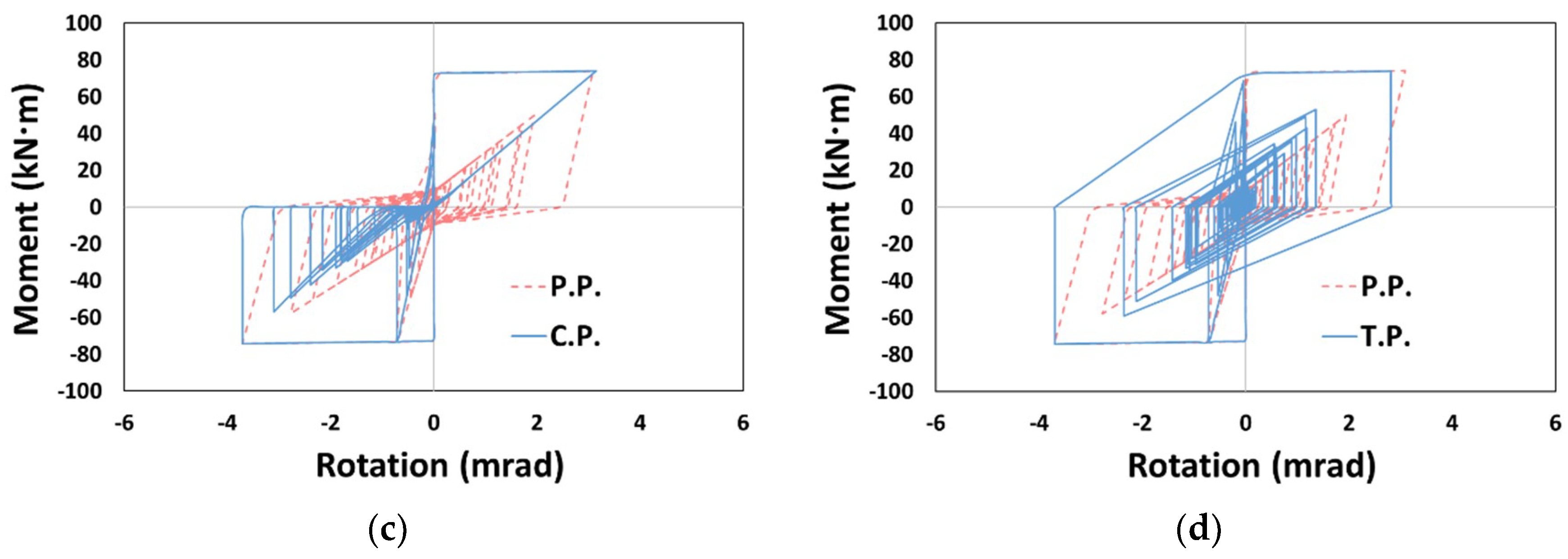
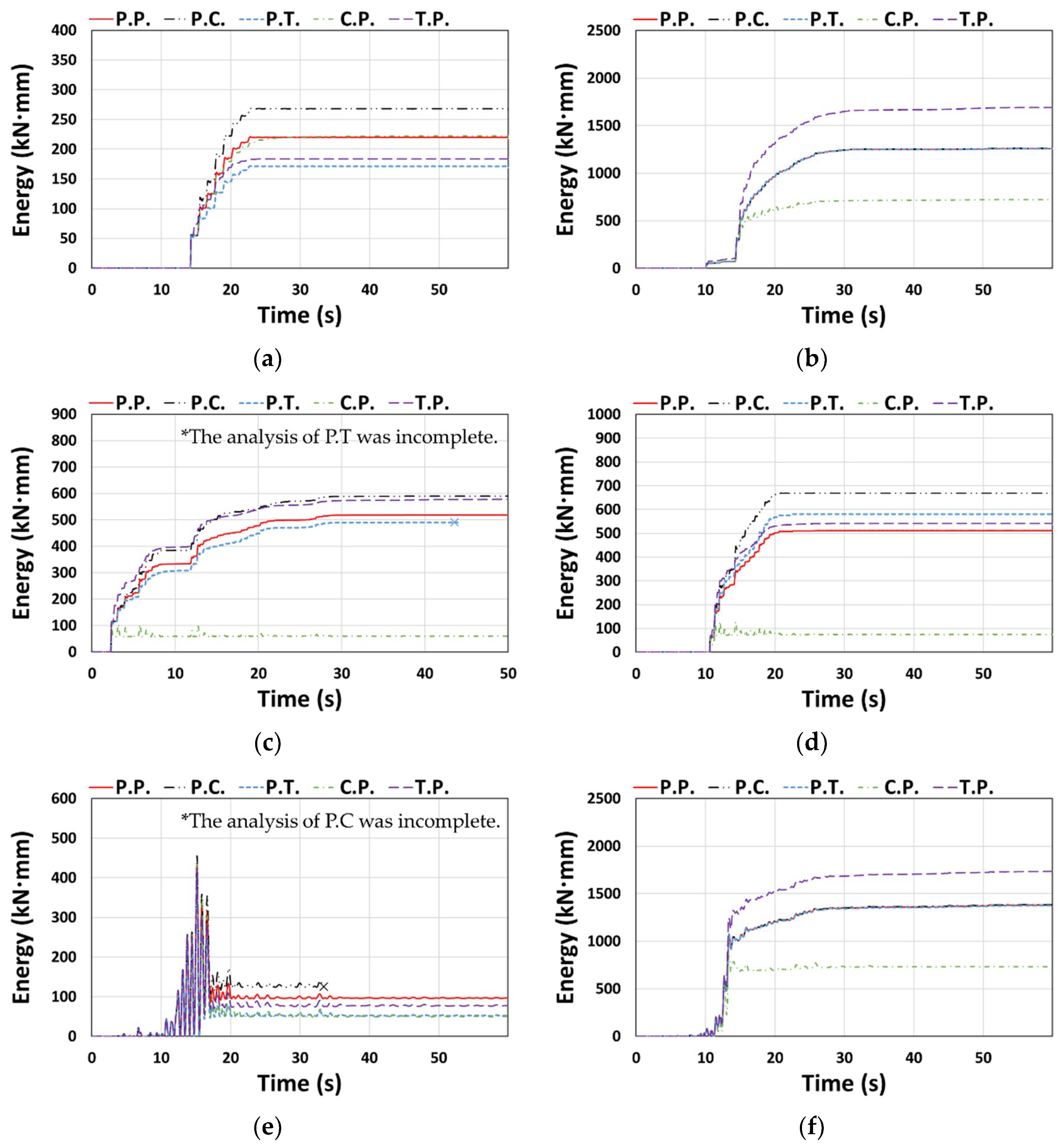
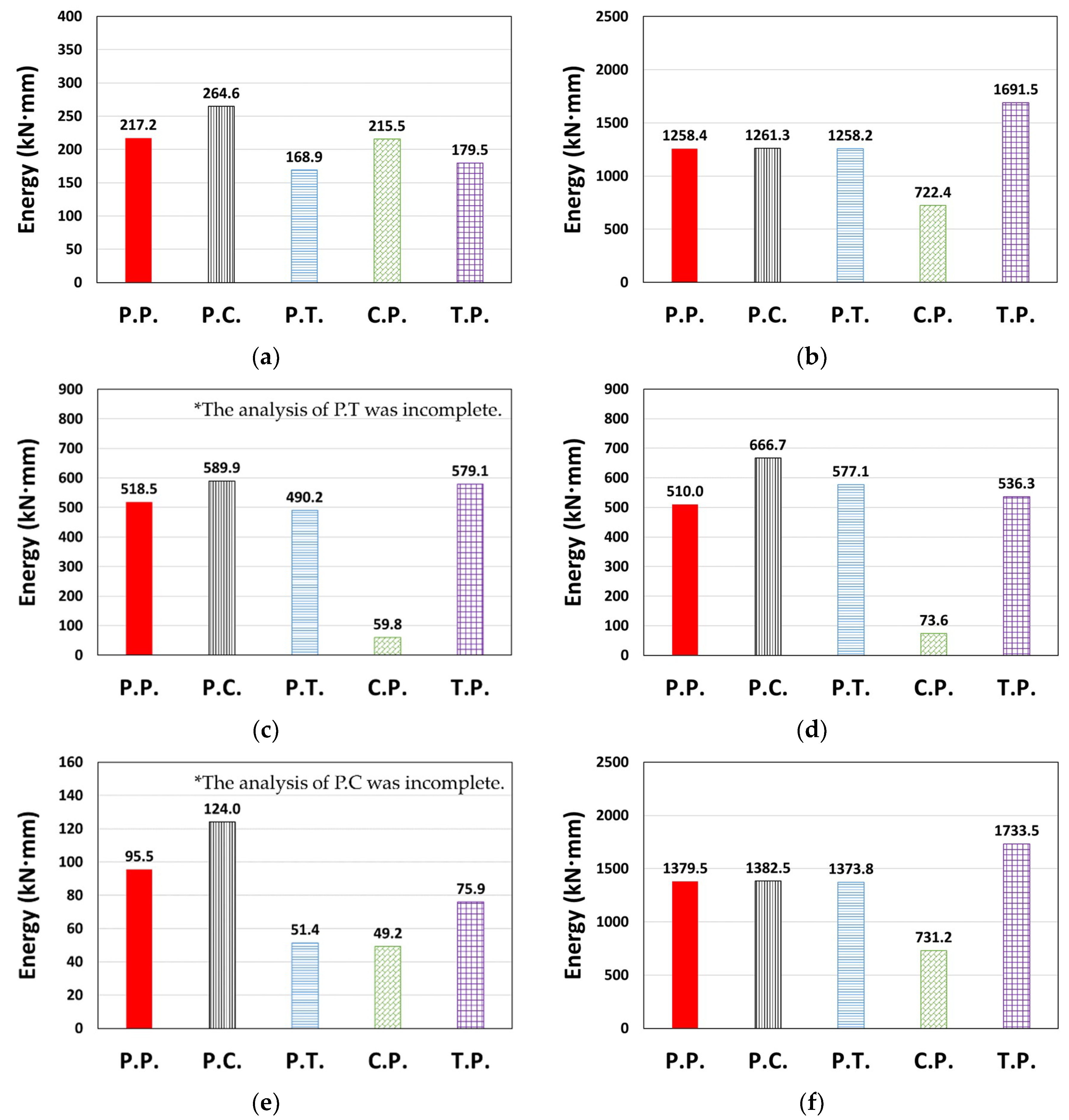
| Classification | Type 1 | Type 2 | Type 3 |
|---|---|---|---|
| Material strength | f′c = 21 MPa, fy = 300 MPa | ||
| Story height (m) | 3.3 | ||
| Story | 3 | 1 | 3 |
| Analysis Model | Applied Hysteresis Model | Remarks | |
|---|---|---|---|
| Beam | Column | ||
| P.P. | Pivot | Pivot | Reference model |
| P.C. | Pivot | Concrete | Column hysteresis model changed |
| P.T. | Pivot | Takeda | |
| C.P. | Concrete | Pivot | Beam hysteresis model changed |
| T.P. | Takeda | Pivot | |
| Response | NSA | NDA | ||
|---|---|---|---|---|
| El Centro | Northridge | Taft | ||
| Base shear (kN) | 2327.4 | 2792.5 | 2639.5 | 1196.0 |
| Roof displacement (mm) | 80.7 | 87.3 | 86.7 | 46.6 |
| Model | Vmax (kN) | Dmax (mm) | Remarks | ||||
|---|---|---|---|---|---|---|---|
| X-dir. | Y-dir. | X-dir. | Y-dir. | ||||
| Type 1 (1000 y return period) | El Centro | P.P. | 2792.5 | 2419.7 | 87.3 | 47.0 | Elastic behavior in Y direction |
| P.C. | 2807.5 | 2419.7 | 90.3 | 47.0 | |||
| P.T. | 2780.4 | 2419.7 | 83.5 | 47.0 | |||
| C.P. | 2806.9 | 2419.7 | 88.5 | 47.0 | |||
| T.P. | 2774.5 | 2419.7 | 86.2 | 47.0 | |||
| Northridge | P.P. | 2639.5 | 2879.0 | 86.7 | 63.9 | - | |
| P.C. | 2638.8 | 2879.0 | 86.4 | 63.9 | |||
| P.T. | 2637.2 | 2879.0 | 85.7 | 63.9 | |||
| C.P. | 2643.7 | 2876.7 | 86.8 | 63.9 | |||
| T.P. | 2634.2 | 2875.2 | 85.8 | 63.8 | |||
| Taft | P.P. | 1196.0 | 1546.6 | 46.6 | 33.0 | Elastic behavior in both X and Y directions | |
| P.C. | 1196.0 | 1546.6 | 46.6 | 33.0 | |||
| P.T. | 1196.0 | 1546.6 | 46.6 | 33.0 | |||
| C.P. | 1196.0 | 1546.6 | 46.6 | 33.0 | |||
| T.P. | 1196.0 | 1546.6 | 46.6 | 33.0 | |||
| Type 2 (2400 y return period) | El Centro | P.P. | 1996.6 | 1587.6 | 70.5 | 46.3 | Analysis of X direction in P.T. was incomplete |
| P.C. | 2001.6 | 1710.5 | 70.7 | 46.3 | |||
| P.T. | 1975.3 | 1532.5 | 70.7 | 46.3 | |||
| C.P. | 1997.5 | 1589.4 | 70.5 | 46.3 | |||
| T.P. | 1996.4 | 1588.1 | 70.4 | 46.3 | |||
| Northridge | P.P. | 2008.2 | 3751.1 | 55.7 | 62.0 | Elastic behavior in X direction | |
| P.C. | 2008.2 | 3751.1 | 55.7 | 64.7 | |||
| P.T. | 2008.2 | 3751.1 | 55.7 | 62.6 | |||
| C.P. | 2008.2 | 3751.1 | 55.7 | 62.3 | |||
| T.P. | 2008.2 | 3751.2 | 55.7 | 61.9 | |||
| Taft | P.P. | 1162.1 | 1186.8 | 43.3 | 36.5 | Elastic behavior in both X and Y directions | |
| P.C. | 1162.1 | 1186.8 | 43.3 | 36.5 | |||
| P.T. | 1162.1 | 1186.8 | 43.3 | 36.5 | |||
| C.P. | 1162.1 | 1186.8 | 43.3 | 36.5 | |||
| T.P. | 1162.1 | 1186.8 | 43.3 | 36.5 | |||
| Type 3 (1000 y return period) | El Centro | P.P. | 1768.4 | 2727.0 | 72.6 | 104.4 | Elastic behavior in X direction |
| P.C. | 1768.4 | 2737.9 | 72.6 | 104.8 | |||
| P.T. | 1768.4 | 2723.8 | 72.6 | 103.2 | |||
| C.P. | 1768.4 | 3041.6 | 72.6 | 118.0 | |||
| T.P. | 1768.4 | 2424.2 | 72.6 | 98.4 | |||
| Northridge | P.P. | 2757.5 | 2470.6 | 124.2 | 82.4 | Analysis of X direction in P.C. was incomplete | |
| P.C. | 2753.7 | 2475.8 | 125.5 | 82.6 | |||
| P.T. | 2757.0 | 2471.6 | 120.7 | 82.0 | |||
| C.P. | 2764.7 | 2604.1 | 125.3 | 86.7 | |||
| T.P. | 2744.0 | 2387.5 | 122.4 | 76.1 | |||
| Taft | P.P. | 1155.0 | 1349.3 | 46.1 | 48.9 | Elastic behavior in both X and Y directions | |
| P.C. | 1155.0 | 1349.3 | 46.1 | 48.9 | |||
| P.T. | 1155.0 | 1349.3 | 46.1 | 48.9 | |||
| C.P. | 1155.0 | 1349.3 | 46.1 | 48.9 | |||
| T.P. | 1155.0 | 1349.3 | 46.1 | 48.9 | |||
Publisher’s Note: MDPI stays neutral with regard to jurisdictional claims in published maps and institutional affiliations. |
© 2021 by the authors. Licensee MDPI, Basel, Switzerland. This article is an open access article distributed under the terms and conditions of the Creative Commons Attribution (CC BY) license (http://creativecommons.org/licenses/by/4.0/).
Share and Cite
Son, J.-K.; Lee, C.-H. Evaluation of Appropriate Hysteresis Model for Nonlinear Dynamic Analysis of Existing Reinforced Concrete Moment Frames. Materials 2021, 14, 524. https://doi.org/10.3390/ma14030524
Son J-K, Lee C-H. Evaluation of Appropriate Hysteresis Model for Nonlinear Dynamic Analysis of Existing Reinforced Concrete Moment Frames. Materials. 2021; 14(3):524. https://doi.org/10.3390/ma14030524
Chicago/Turabian StyleSon, Joo-Ki, and Chang-Hwan Lee. 2021. "Evaluation of Appropriate Hysteresis Model for Nonlinear Dynamic Analysis of Existing Reinforced Concrete Moment Frames" Materials 14, no. 3: 524. https://doi.org/10.3390/ma14030524
APA StyleSon, J.-K., & Lee, C.-H. (2021). Evaluation of Appropriate Hysteresis Model for Nonlinear Dynamic Analysis of Existing Reinforced Concrete Moment Frames. Materials, 14(3), 524. https://doi.org/10.3390/ma14030524






